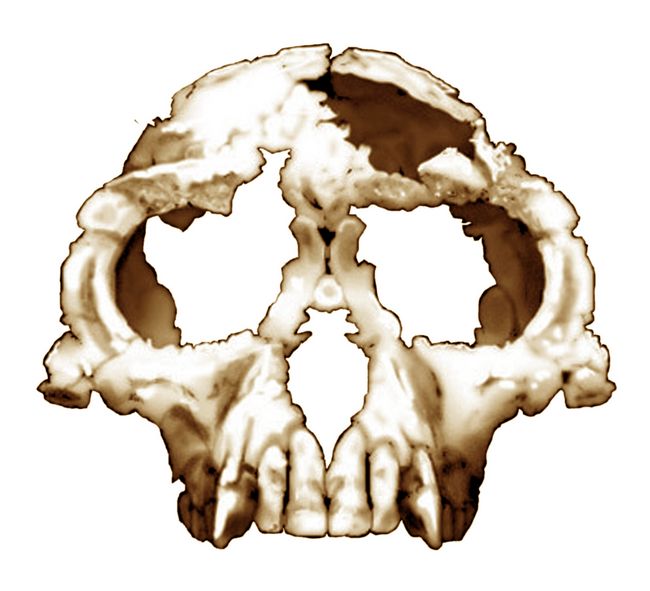Athena Review Image Archive ™
Ardipithecus ramidus skull

Skull of Ardipithecus ramidus
Ardipithecus ("basal ape") lived during the Late Miocene and Early Pliocene periods in the Afar Depression of Ethiopia. Two fossil species include A. ramidus, which lived about 4.4 mya during the early Pliocene, and A. kadabba, dated to approximately 5.6 mya in the late Miocene.
The first A. ramidus fossils were found in 1992–1994 by White and his colleagues (1994) in the Afar Depression in the Middle Awash river valley of Ethiopia, including the skull, mandible, teeth, and up to 45% of the skeleton. This was originally described as a species of Australopithecus, but later renamed Ardipithecus. This fossil was dated to 4.4 mya on the basis of its stratigraphic position between two volcanic layers. Thereafter, in 1999-2003, bones and teeth of nine A. ramidus individuals were discovered in the Gona area of Ethiopia's Afar Region, dated to between 4.35 and 4.45 mya.
In 2009 was announced the
relatively complete A. ramidus
fossil skeleton of a 50-kilogram (110 lb)
female, nicknamed "Ardi", discovered in 1994 at Aramis in the Afar
desert (White et al. 2009). Layers of volcanic ash encasing
the deposits have been radiometrically dated to 4.3-4.5 million
years ago.
This date, however, has been questioned by others who propose Ardi
should be dated at
3.9 mya, much closer to the dates of Australopithecus afarensis (Kappelman and Fleagle 1995).
The relation of Ardipithecus ramidus to human ancestors
is a matter of debate (Stanford 2012). Behavioral analysis showed that
Ardipithecus could be very
similar to chimpanzees. Like most hominids, but
unlike all previously recognized hominins, it had a grasping big
toe (hallix) adapted for locomotion in the trees. It is not confirmed
how
much other features of its skeleton reflect adaptation to bipedalism on
the ground as well.
A. ramidus had a relatively small cranial capacity of 300 -350 cm3, slightly smaller than a modern bonobo or female common chimpanzee
brain; smaller still than the brain of Australopithecus afarensis (~400 to 550 cm3), dating from about 3.3 mya; and only 20% the size of the modern Homo sapiens
brain.
As in common chimpanzees, the face of A. ramidus was much more prognathic
than that of modern humans. The teeth of A. ramidus lacked the
specialization of other apes, indicating it was a generalized
omnivore and fruit eater with a diet that did not depend
heavily on foliage, fibrous plant material, or other abrasive food. Like later hominins, meanwhile, Ardipithecus had reduced
canine teeth. The size of the upper canine tooth in A.
ramidus males was not distinctly different from that of females, which contrasts with the sexual
dimorphism observed in common chimpanzees. Since A ramidus
is in some ways unlike chimpanzees, the common ancestor of humans and
chimps may have differed significantly from the modern chimpanzee.
The second species of Ardipithecus, A. kadabba, is
defined from teeth and fragments of skeletal
bones, and is dated at 5.6 mya. In 2004 it was proposed as a separate
species, based on tooth evidence showing primitive morphology and wear
pattern distinct from those of A. ramidus (Haile-Selassie et al. 2004).
References
Haile-Selassie, Y., G. Suwa and T.D. White, 2004. Late Miocene Teeth from Middle Awash, Ethiopia, and Early Hominid Dental Evolution. Science. 303 (5663): 1503–5.
Kappelman, J. and J.G. Fleagle 1995. Age of early hominids. Nature. 376 (6541): 558–559.
Stanford, C.B. 2012 Chimpanzees and the Behavior of Ardipithecus ramidus. Annual Review of Anthropology. 41: 139–49.
White, T.D.; G. Suwa, and B. Asfaw, 1994.. Australopithecus ramidus, a new species of early hominid from Aramis, Ethiopia. Nature. 371 (6495): 306–12.
White, T. D., B Asfaw, Y. Beyene, Y. Haile-Selassie, V.O. Lovejoy, G. Suwa, and G. Woldegabriel, G. 2009. Ardipithecus ramidus and the Paleobiology of Early Hominids. Science. 326 (5949).
.
Copyright © 1996-2020 Rust Family Foundation (All Rights Reserved).